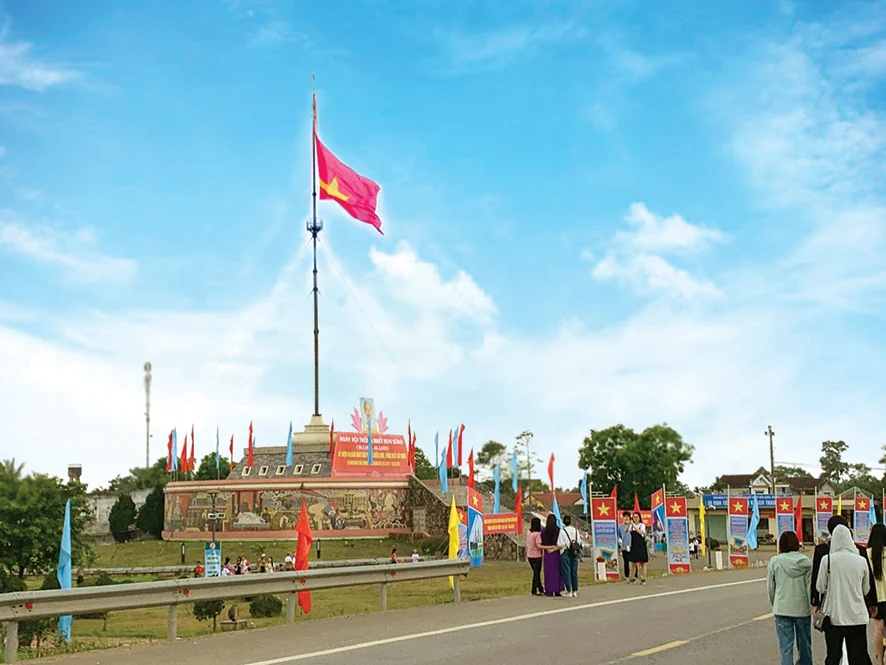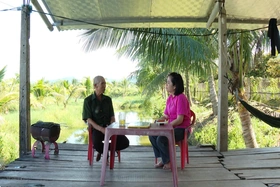{title}
{publish}
{head}
When I write these lines, my mother has already passed away. She now rests peacefully in the fields of her homeland, near the foot of Hien Luong Bridge. Her head lies on the river dike of the Ben Hai River, facing her beloved village of Hien Luong. The gentle river murmurs, its waves softly lulling her to sleep — the sleep of a mother who, for years, quietly and diligently worked each stitch to keep the national flag at the bridgehead intact, always flying high in the wind amid the enemy’s bombs and bullets. That mother was Ngo Thi Diem, whom the people of Vinh Linh would later call “the mother who mended the national flag.”
I returned to Hien Luong village in the middle of harvest season. The vast fields were filled with the rich scent of ripening rice, glowing golden under the sun. The Sa Lung River curved like a sky-blue silk ribbon embracing the village. In front of me stretched the smooth, glistening North–South trunk road, as graceful as a young woman’s flowing hair. Guided by locals, I sought out Mr. Hoang Kha, a former militia member of Hien Luong village.

The Hien Luong Flag Tower on Festival Day
Mr. Hoang Kha recalled: "The national flag at the foot of Hien Luong Bridge during the years of division between North and South Vietnam was a symbol of revolutionary heroism. It embodied the burning hope and unwavering faith of Southern compatriots looking toward the North. At the same time, it was a terrifying nightmare for the enemy.
That’s why, from the moment the US-Saigon regime escalated its attacks on the North and on Vinh Linh in particular, their top priority was to destroy the flagpole at Hien Luong using air strikes and artillery. No one could calculate the number of tons of bombs and shells the Americans dropped just to break that one flagpole. But the soldiers and people of Vinh Linh fought bravely to protect the sacred flag of the homeland.”
Lieutenant Colonel Tran Bien, a former soldier of the Vinh Linh military unit, shared his memories: “The most intense bombardment of Hien Luong occurred in 1967. They deployed constant aerial bombing while shelling from the 7th Fleet offshore and launching artillery fire from Doc Mieu. One of their missiles eventually brought down the flagpole.
The enemy was thrilled to see the Hien Luong flagpole fall. But their joy was short-lived. Overnight, our soldiers erected a tall wooden casuarina pole on the same spot, and by morning, a red flag with a yellow star once again fluttered defiantly in the wind. The enemy resumed their attacks day and night, and Hien Luong was once again engulfed in fire and smoke.
Every day, American ‘iron birds’—F105s, AD6s, F4s—swarmed the sky in relentless bombing raids. Yet, strangely, the skies above Hien Luong always blazed bright with the red and yellow of our flag. To protect the flag, we established dozens of defensive positions and kilometers of trenches stretching from Vinh Giang to Vinh Hoa, Vinh Thanh, and Vinh Nam.
Between late 1966 and early 1970, our forces engaged in over 300 battles, big and small. The most significant and costly for the enemy occurred on March 20, 1967. That day, hundreds of our artillery, recoilless rifles, and rockets from across Vinh Linh opened fire on the Doc Mieu base, killing 1,070 enemy troops.
In that battle, one of our soldiers climbed to the top of the flagpole, wrapped himself in a corner of the national flag for camouflage, and used binoculars to direct our artillery fire with deadly accuracy. In retaliation, the enemy unleashed more air strikes on Hien Luong. Again, the flagpole was broken and the flag torn. We had to replace both once more.
Our resolve was that not a single day, not even a single moment, should pass without the national flag flying over Hien Luong. Back then, we had a dedicated flag-sewing station in Vinh Nam commune. Some days we replaced the flag up to eight or ten times. When we no longer had enough intact flags, we began patching them. That’s when a mother from Hien Luong took up the task of mending the flags.
At the time, Mother Ngo Thi Diem was 45, one of four elderly women who remained in the village instead of evacuating to Tan Ky, Nghe An. Those who stayed were assigned to cook for soldiers, police, and militia on the front line, care for the wounded, and do laundry and sewing.
One evening at dusk, as she was washing clothes by the Sa Lung River, a strange man with a Northern accent approached her asking for directions to the Ben Hai River. At first, she assumed he was a government official and was about to give him directions, but something about his demeanor felt off. She became suspicious and cleverly managed to bring him back to her home.
Her house was frequently used by border guard officers from Hien Luong outpost. After questioning, the man confessed to being a U.S.-Saigon spy trying to return south. He was arrested, and the entire village—from militia to soldiers and police—celebrated her quick thinking and bravery.
Over time, the soldiers and police came to see Mother Diem as family. Whenever the flag at Hien Luong was torn by US bombs, the officers would bring it back to their shelter to mend. Seeing their clumsy hands struggle with needle and thread, she felt both amused and deeply moved, and began patching the flags herself.
Each flag damaged by bombing was gently washed and carefully mended by her hands. As the war grew fiercer, Hien Luong was ravaged, and many of our soldiers gave their lives to keep the flag standing tall. Mother Diem buried her sorrow and focused entirely on her work. She needed to sew faster, with stronger, neater stitches.
The patched flags had to be beautiful, straight, and clean. She sewed by day, by night, even while in air raid shelters or trenches, even as planes roared overhead. Never before had she felt such love for her country as when sewing its flag. And never had the homeland felt so close and sacred as during those burning days.
Through stories told by the village militia about Mother Ngo Thi Diem, I began to picture what her time mending the national flag must have been like. Perhaps it was not the whole story, but it reflected the depth of her devotion to that flag at the frontline.
Mother Hoang Thi Tuat, one of three women who joined in mending flags back then, recalled emotionally: “At first, I only cooked for the soldiers and militia. But the bombing was so intense, the flags tore too often, and Diem couldn’t keep up. So they brought me and Vien in to help.
Among the three of us, Vien was the oldest, then me, then Diem. Diem was not only younger but also beautiful and kind, and she was amazing at sewing. She could mend torn uniforms with her hands as neatly as if done by machine. She sewed flags quickly and carefully, while Vien and I could barely keep up. Those were tough times, with bombs and bullets everywhere, but somehow, they were joyful too.”
I asked Mr. Hoang Kha, “Do you remember how large our flag was at the Hien Luong Bridge back then?” After a pause, he answered, “Before the metal pole was destroyed by US bombs, our flag was over a hundred square meters. The pole stood more than twenty meters tall. It was much bigger than the enemy’s flag on the southern bank.
Later, because of constant bombing, the flagpole was repeatedly broken. But we couldn’t let the national flag stop flying for even a second. So we replaced the pole with a 15-meter-tall wooden casuarina one, and the flag then measured only a few dozen square meters.”
“How long did Mother Diem keep mending flags?” I asked. “About two years, maybe a little more,” Mr. Kha replied.
I tried to estimate how many meters of torn flag fabric Mother Ngo Thi Diem and the women of Hien Luong might have sewn during those years. A thousand meters? Five thousand? Ten thousand—or more? I could never count how many flags she mended. All I know is that my mother’s work—patching the national flag by the banks of this historic river—has now become legend. A legend soaked in the blood of countless compatriots and comrades on this land of Vinh Linh, a land that endured immense loss and pain, yet remained heroic and unyielding. And that legend will live on forever, passed down through generations.
I quietly wish that she were still alive today to witness with her own eyes the profound changes in her homeland. Hien Luong village is now a peaceful, quiet place. The bright red roofs of new houses blend gently into the lush green of rice fields, vegetable gardens, shrimp ponds, and fish lakes.
The Hien Luong Bridge has been rebuilt—grander, more solid than before. And my mother, the woman who once mended the national flag under fire, has been posthumously awarded the title Hero of the People’s Armed Forces by the President. I stood quietly by her grave, lighting incense sticks, silently praying that her soul rests peacefully in the afterlife.
Beyond, the gentle sound of waves murmurs against the banks. The Hien Luong Bridge of her time has been restored and now stretches proudly across the river. The national flag flying high from the restored flag tower flutters in the wind, a symbol of a unified, independent nation—and a people’s enduring desire for peace.
Nguyen Ngoc Chien - Ngoc Mai

QTO - Not letting summer slip by in vain, many students in Quang Tri have taken the initiative to teach English to younger children. Through each lesson,...

QTO - Returning from the northern border front with a 2/4 disability, it seemed his journey of service had come to an end. Yet, this wounded soldier began...